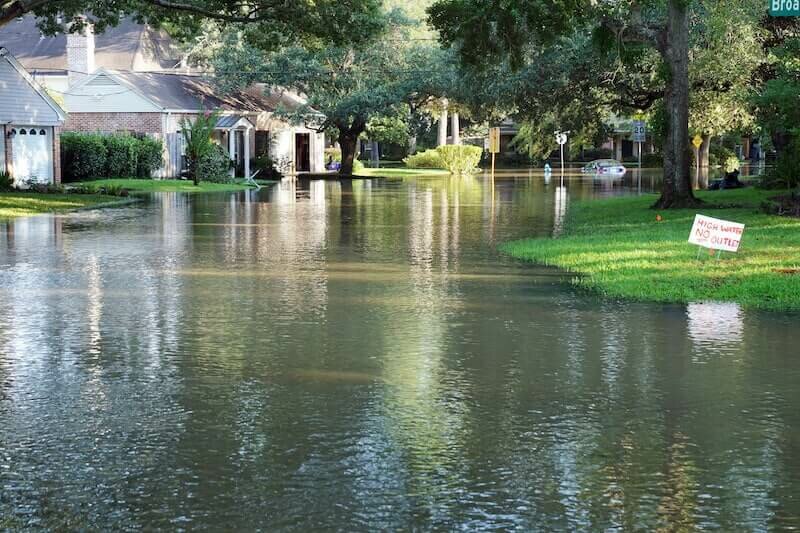Flooding is quite common throughout the USA, specifically in Texas though, flooding is a regular occurrence. Whether you live in Fort Worth, Granbury, or DFW, there is a risk of flooding in all of these locations, not just in Houston by the Gulf.
As a homeowner, you might have known the risks of buying in your area and went ahead and got flood insurance years ago, but now that you’d like to sell your house, living in a floodplain is a bigger deal. Unfortunately, seeing the words “in a floodplain” instantly distracts buyers from looking at your home.
But what if you’re unsure if your home’s location should even be classified as in a flood zone? What are you required to disclose to buyers? What improvements could be made to ease a buyer’s mind to purchase a house in a flood zone?
Below we’ll dive into everything you should know when selling a house in a floodplain in Texas, so let’s get started!
Selling a house, in general, can be challenging; selling a property in a flood zone has a different set of obstacles. However, the good news is that it can be done. You’ll just want to get your information to answer buyer questions and know the flood zone rules and laws in TX, to help this home sale run smoothly.

Flood Zone Variances and Insurance Basics for TX
As you research your area, you may see the phrase “flood zone variances” pop up. Basically, a variance is an authorization for the construction or maintenance of a structure, or other land uses that would otherwise be prohibited by a land-use regulation such as a zoning ordinance.
For National Flood Insurance Program (NFIP) purposes, a variance is a grant of relief by a community from floodplain management regulations. It is granted for floodplain management purposes only; meaning flood insurance will still be rated according to risk- which we’ll explain the different risk categories later on.
However, speaking of flood insurance, the state of Texas doesn’t require homeowners to have flood insurance, but you may need to purchase coverage as a condition of your mortgage.
Even if you’re not required to purchase flood insurance, you may want to buy coverage, as Texas consistently has some of the highest fatality rates and property damage costs due to flooding. Nearly one in four flood losses occurs in flood plains that aren’t considered high-risk, so even when coverage isn’t required, it doesn’t necessarily mean your property is safe.
Private insurance companies can offer flood insurance policies, but the government also provides a federal flood insurance policy. However, a community must participate in the National Flood Insurance Program (NFIP) for residents and businesses to be eligible to purchase flood insurance through the national program. If your community does not participate, flood insurance through the NFIP is unavailable, and eligibility for federal disaster assistance is minimal. In addition, homeowners may find it hard to secure a mortgage.
About The National Flood Insurance Program (NFIP)
The National Flood Insurance Program (NFIP) was created by Congress in 1968 to protect lives and property and reduce the financial burden of providing disaster assistance. The NFIP is administered by the Federal Emergency Management Agency (FEMA).
Nationwide, over 22,000 communities participate in the NFIP-including many in Texas. The NFIP is based on a mutual agreement between the Federal Government and communities. Communities that participate agree to regulate floodplain development according to specific criteria and standards. The partnership involves:
- Flood Hazard Maps – FEMA prepares maps that are used by communities, insurance agents, and others.
- Flood Insurance – Property owners in participating communities are eligible to purchase federal flood insurance for buildings and contents.
- Regulations – Communities must agree to adopt and enforce floodplain management regulations so that development, including buildings, is undertaken in ways that reduce exposure to flooding.
Flood Zone Rules and Laws in Texas
FEMA created some flood zone rules or designated geographic flood zones that are based on the varying levels of flood risk. The zones are depicted on a community Flood Hazard Boundary May (FHBM) or FIRM and Digital Firms (DFIRMS). Each zone reflects the severity or type of flooding in the area.
The flood zone rules are as follows:
- High-Risk Areas– All A and V Zones- means the area is located within the 1% annual chance floodplain (100-year floodplain), identified as a Special Flood Hazard Areas on Flood Insurance Rate Maps. Flood insurance is available to all property owners and renters. Lenders require the mandatory purchase of flood insurance.
- Moderate to Low-Risk Areas– Zones B (moderate), C, and X (low) – areas located outside the one percent annual chance of floodplain. This includes areas protected from a flood by certified levees. A dwelling that is higher than base flood elevation. Lower-cost flood insurance is available to all property owners and renters. Mandatory flood insurance purchase requirements apply.
- Undetermined Risk Areas– Zone D- Unstudied areas of uncertain but possible flood hazards. Base flood elevations are not available. Flood insurance is available to all property owners and renters; mandatory flood insurance purchase requirements do not apply.
*Image from the Texas Water Development Board, 2015 Quick Guide Floodplain Management in Texas
Now that you understand the classifications of flooding, you’ll want to figure out what flood zone you fall into and what mandatory flood zone rules regarding flood insurance apply to you.
You can check your zone using FEMA’s Flood Map Service Center. To find out if your community participates in the National Flood Insurance Program (NFIP), go to FEMA’s National Flood Insurance Program Community Status Book or talk to your insurance agent.
Disclosure Laws in Texas
Compared to the rest of the USA, Texas is ranked A (Best) in regards to disclosure laws required by sellers to share with potential buyers. For example, Texas disclosure laws require the seller to disclose whether:
- There have been previous water damage to a structure due to a natural flood event.
- There have been previous flooding due to a natural failure or breach of a reservoir or a controlled emergency release of water from a reservoir.
- The property is located wholly or partly in a 100-year floodplain, a 500-year floodplain, or a reservoir.
- The seller has ever filed a claim for flood damage to property with any insurance provider, including the National Flood Insurance Program.
- If flood insurance covers the property, and the seller ever received assistance from FEMA or the U.S. Small Business Administration (SBA) for flood damage to the property.
It’s essential to be honest, and truthful if your home is in a floodplain- the reason being this is a crucial material fact that could impact your property’s value or safety.
Also, if you’ve received federal disaster assistance on your home, you will be required to get flood insurance at your address. From there, federal law does require that when you sell your house, the new homeowners be informed that they’ll need to continue insurance coverage on the place, according to FEMA.
If you have any questions about what you’re legally required to disclose, talking to a skilled real estate attorney would be helpful.
Getting Elevation and Certification
If you’re uncertain about your property’s zone classification, you can have a surveyor provide an elevation certificate that you can submit to FEMA to be removed from that flood zone.
In fact, FEMA has advised that questioning your zone could positively affect policyholders with grandfathered policies to pay less for their flood insurance today if they had specific elevation information for their structure.
An elevation certificate is a document that verifies a building’s location, flood zone, lowest point of elevation, and other specifics. If your home is considered to have a high risk of flooding, you’ll likely need to obtain FEMA’s elevation certificate for your dwelling before you can buy flood insurance.
If you’re able to get proof that you’re in the wrong zone, you can go online and submit a Letter of Map Change (LOMC) request. In addition, the eLOMA site allows professional engineers and licensed land surveyors to submit a Letter of Map Amendment for you.
Flood Zone Declaration to Potential Buyers
Once you figure out your accurate flood zone, if you haven’t already done so, you’ll want to share your property’s history with potential buyers; this also may include the flood zone declaration page. That’s a computer-generated summary of the information provided by the prospective policyholder in the application for flood insurance. The declarations page also describes the policy’s terms and coverage limits and displays the premium and the insurer’s name. Again, this may be helpful for a buyer to look over to understand what type of policy they’ll need and how much it costs.
No matter whats, it’s a good idea to be transparent about your flood zone and any history of flooding, even if you’re worried it will scare buyers away. On the contrary, it may have the opposite effect and help you put buyers’ minds at ease by presenting them with cold hard facts.
If you haven’t ever had to pay a claim for flooding or the area hasn’t flooded for many years- that can work to your advantage. You can request a claims information report generated by LexisNexis, a consumer reporting agency, that can show buyers your home’s lack of flood events with clear documentation. By showing prospective buyers that no claims have been filed and the risk of flooding is low, you should be able to alleviate some of their concerns.
Home Improvements to Reduce Flooding Risk
Another way you can put buyer’s minds at ease is to make home improvements that help reduce flooding risks. Of course, the best line of defense against water intrusion when you live in a flood-prone area is elevation. But, unfortunately, raising a home that’s already been built will cost you between $180,000-$250,000, not exactly a worthwhile expense for everyday homeowners.
Other ways you can floodproof are more for when you know a flood is coming, like installing watertight protection over your windows and doors. However, there are some sufficient and more permanent flood-proofing measures you can take before you sell your house, which a buyer might find value in.
Below are a few suggestions provided by the NRDC:
- Place absorbent mulch in your yard
- Raise your utilities (HVAC system or boiler) to higher ground by building a platform or relocating them to a higher floor.
- Hire a licensed plumber to install a sewage water backstop device
- Place a rain barrel beneath gutter downspouts
- Use landscaping techniques like digging ditches known as swales to channel stormwater runoff.
- Go for brick and gravel driveways rather than concrete or asphalt to reduce potential flood damage.
And of course, make sure to fix any issues in your home that leave it vulnerable to water damage, such as foundation issues, damaged roofing, rotting wood, or siding.
Improvements and repairs are essential to make when selling a house in a floodplain. But if you don’t have the time nor the money to make these advisable changes, you can always sell your home as-is instead.
Ways to Sell a House in a Floodplain
There are several ways to sell a house in a floodplain. However, if you’re going about it the traditional way, it’s important to get your ducks in a row. If you’ve never filed a claim against your home, make sure to get a report.
If you don’t have flood insurance because it’s not required, you still may want to consider getting it before putting your house on the market. FEMA advises homeowners to purchase flood insurance even if they live outside a high-risk flood zone, called a Special Flood Hazard Area. Doing so would also help protect your property should a flood occur while it’s on the market.
Whether you sell by owner or sell with a real estate agent, you’ll want to be upfront and honest about the location of your home and the risk of it being in a floodplain. Also, listing during the best time to sell your house should help in the success of your home sale because inventory is low, and there is less competition.
But, if selling your house in a flood zone proves to be more of a challenge than you thought it would be, or you’d prefer not to invest any more money into home improvements to reduce flooding risks – you can always “sell my house fast Granbury,” Wichita Falls, Fort Worth, Dallas, or Houston by selling to a cash home buyer instead.

Selling to Cash Home Buyers
Unfortunately, depending on where your home is located and its condition, you may not see buyers lined up at your door to make you an offer. Usually, words like “in a floodplain,” “foundation damage,” or “water damage” throw up red flags for buyers and send them in the opposite direction of your home.
But selling to cash home buyers in Fort Worth, however, doesn’t. They get that selling a house in a floodplain can be difficult, and if you need to sell right away, you need a buyer you can count on.
Cash home buyers purchase houses in any location, any condition, with any issues. They also don’t use traditional bank financing to buy a home but instead cash, so not only can they make you an offer within 24 hours but can close in as little as 7 days.
Working with an agent or even selling by owner involves realtor commissions that can be pretty hefty; however, selling to a local cash home buyer like Four 19 Properties can be done without agents, meaning no expensive commissions to pay.
There are several advantages to selling to Four 19 Properties you’ll want to explore, especially if you’d prefer to avoid making major repairs and sitting on the market for months waiting for a buyer to come along who will purchase your house in a floodplain.
Selling Your Home at a Lower Price
If you’re still uncertain about selling your house to a cash home buyer like Four 19 Properties, you can always try selling on the real estate market. But you’ll need to find a buyer who’s not overly concerned about your property’s location (i.e., in a flood zone). This could be incentivized by a lower asking price.
However, you’ll want to keep in mind that even if you’re able to find a motivated buyer, they will have to get approval from their lender, which may be tricky given the risk your property will involve.
Lastly, if you were to lower your asking price, just remember that realtor commissions will likely be involved with your transaction, which cost as much as 5-6% of your home sale, reducing your profits even more.
Final Takeaways
Trying to sell a house in a floodplain is possible; however, you’ll need to provide information to buyers and make improvements to your home to put prospective buyers at ease. Even with your best efforts while being upfront and honest, this may not provide you a buyer or the profits you were hoping for. But by selling to a “buy my house Rhode Texas” company, you’ll be able to quickly sell your house as-is and avoid the hassle that comes with a traditional home sale.
Four 19 Properties has worked with several Texas homeowners needing to sell quickly but with obstacles like living in a flood zone, and they can help you too!
Contact Four 19 Properties today to find out how to sell your house fast!
